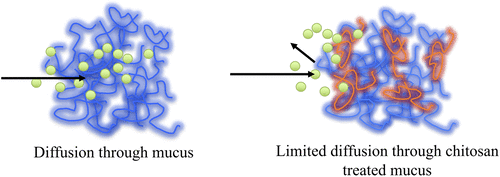当前位置:
X-MOL 学术
›
Biomacromolecules
›
论文详情
Our official English website, www.x-mol.net, welcomes your
feedback! (Note: you will need to create a separate account there.)
Reinforcing Mucus Barrier Properties with Low Molar Mass Chitosans
Biomacromolecules ( IF 5.5 ) Pub Date : 2018-02-16 00:00:00 , DOI: 10.1021/acs.biomac.7b01670 Sujit Kootala 1 , Luimar Filho 2 , Vaibhav Srivastava 1 , Victoria Linderberg 1 , Amani Moussa 3 , Laurent David 3 , Stéphane Trombotto 3 , Thomas Crouzier 1
Biomacromolecules ( IF 5.5 ) Pub Date : 2018-02-16 00:00:00 , DOI: 10.1021/acs.biomac.7b01670 Sujit Kootala 1 , Luimar Filho 2 , Vaibhav Srivastava 1 , Victoria Linderberg 1 , Amani Moussa 3 , Laurent David 3 , Stéphane Trombotto 3 , Thomas Crouzier 1
Affiliation

|
The mucus gel covers the wet epithelia that forms the inner lining of the body. It constitutes our first line of defense protecting the body from infections and other deleterious molecules. Failure of the mucus barrier can lead to the inflammation of the mucosa such as in inflammatory bowel diseases. Unfortunately, there are no effective strategies that reinforce the mucus barrier properties to recover or enhance its ability to protect the epithelium. Herein, we describe a mucus engineering approach that addresses this issue where we physically cross-link the mucus gel with low molar mass chitosan variants to reinforce its barrier functions. We tested the effect of these chitosans on mucus using in-lab purified porcine gastric mucins, which mimic the native properties of mucus, and on mucus-secreting HT29-MTX epithelial cell cultures. We found that the lowest molar mass chitosan variant (degree of polymerization of 8) diffuses deep into the mucus gels while physically cross-linking the mucin polymers, whereas the higher molar mass chitosan variants (degree of polymerization of 52 and 100) interact only superficially. The complexation resulted in a tighter mucin polymer mesh that slowed the diffusion of dextran polymers and of the cholera toxin B subunit protein through the mucus gels. These results uncover a new use for low molar mass mucoadhesive polymers such as chitosans as noncytotoxic mucosal barrier enhancers that could be valuable in the prevention and treatment of mucosal diseases.
中文翻译:

低摩尔质量的壳聚糖增强粘液屏障性能
粘液凝胶覆盖形成上皮的湿上皮。它是我们保护人体免受感染和其他有害分子侵害的第一道防线。粘液屏障的破坏可导致粘膜发炎,例如在炎症性肠病中。不幸的是,没有有效的策略来增强粘液屏障的特性,以恢复或增强其保护上皮的能力。在这里,我们描述了解决此问题的粘液工程方法,其中我们将粘液凝胶与低摩尔质量的壳聚糖变体进行物理交联,以增强其屏障功能。我们使用实验室内纯化的猪胃粘蛋白(模拟粘液的天然特性)和分泌粘液的HT29-MTX上皮细胞培养物测试了这些壳聚糖对粘液的作用。我们发现最低摩尔质量的壳聚糖变体(聚合度为8)扩散到粘液凝胶中,同时物理地交联粘蛋白聚合物,而较高摩尔质量的壳聚糖变体(聚合度为52和100)仅在表面相互作用。络合导致粘蛋白聚合物网格更紧密,从而减慢了葡聚糖聚合物和霍乱毒素B亚基蛋白通过粘液凝胶的扩散。这些结果揭示了低摩尔质量的粘膜粘附聚合物(例如壳聚糖)作为无细胞毒性粘膜屏障增强剂的新用途,这在预防和治疗粘膜疾病方面可能是有价值的。而较高摩尔质量的壳聚糖变体(聚合度为52和100)仅在表面发生相互作用。络合导致粘蛋白聚合物网格更紧密,从而减慢了葡聚糖聚合物和霍乱毒素B亚基蛋白通过粘液凝胶的扩散。这些结果揭示了低摩尔质量的粘膜粘附聚合物(例如壳聚糖)作为无细胞毒性粘膜屏障增强剂的新用途,这在预防和治疗粘膜疾病方面可能是有价值的。而较高摩尔质量的壳聚糖变体(聚合度为52和100)仅在表面发生相互作用。络合导致粘蛋白聚合物网格更紧密,从而减慢了葡聚糖聚合物和霍乱毒素B亚基蛋白通过粘液凝胶的扩散。这些结果揭示了低摩尔质量的粘膜粘附聚合物(例如壳聚糖)作为无细胞毒性粘膜屏障增强剂的新用途,这在预防和治疗粘膜疾病方面可能是有价值的。
更新日期:2018-02-16
中文翻译:

低摩尔质量的壳聚糖增强粘液屏障性能
粘液凝胶覆盖形成上皮的湿上皮。它是我们保护人体免受感染和其他有害分子侵害的第一道防线。粘液屏障的破坏可导致粘膜发炎,例如在炎症性肠病中。不幸的是,没有有效的策略来增强粘液屏障的特性,以恢复或增强其保护上皮的能力。在这里,我们描述了解决此问题的粘液工程方法,其中我们将粘液凝胶与低摩尔质量的壳聚糖变体进行物理交联,以增强其屏障功能。我们使用实验室内纯化的猪胃粘蛋白(模拟粘液的天然特性)和分泌粘液的HT29-MTX上皮细胞培养物测试了这些壳聚糖对粘液的作用。我们发现最低摩尔质量的壳聚糖变体(聚合度为8)扩散到粘液凝胶中,同时物理地交联粘蛋白聚合物,而较高摩尔质量的壳聚糖变体(聚合度为52和100)仅在表面相互作用。络合导致粘蛋白聚合物网格更紧密,从而减慢了葡聚糖聚合物和霍乱毒素B亚基蛋白通过粘液凝胶的扩散。这些结果揭示了低摩尔质量的粘膜粘附聚合物(例如壳聚糖)作为无细胞毒性粘膜屏障增强剂的新用途,这在预防和治疗粘膜疾病方面可能是有价值的。而较高摩尔质量的壳聚糖变体(聚合度为52和100)仅在表面发生相互作用。络合导致粘蛋白聚合物网格更紧密,从而减慢了葡聚糖聚合物和霍乱毒素B亚基蛋白通过粘液凝胶的扩散。这些结果揭示了低摩尔质量的粘膜粘附聚合物(例如壳聚糖)作为无细胞毒性粘膜屏障增强剂的新用途,这在预防和治疗粘膜疾病方面可能是有价值的。而较高摩尔质量的壳聚糖变体(聚合度为52和100)仅在表面发生相互作用。络合导致粘蛋白聚合物网格更紧密,从而减慢了葡聚糖聚合物和霍乱毒素B亚基蛋白通过粘液凝胶的扩散。这些结果揭示了低摩尔质量的粘膜粘附聚合物(例如壳聚糖)作为无细胞毒性粘膜屏障增强剂的新用途,这在预防和治疗粘膜疾病方面可能是有价值的。











































 京公网安备 11010802027423号
京公网安备 11010802027423号